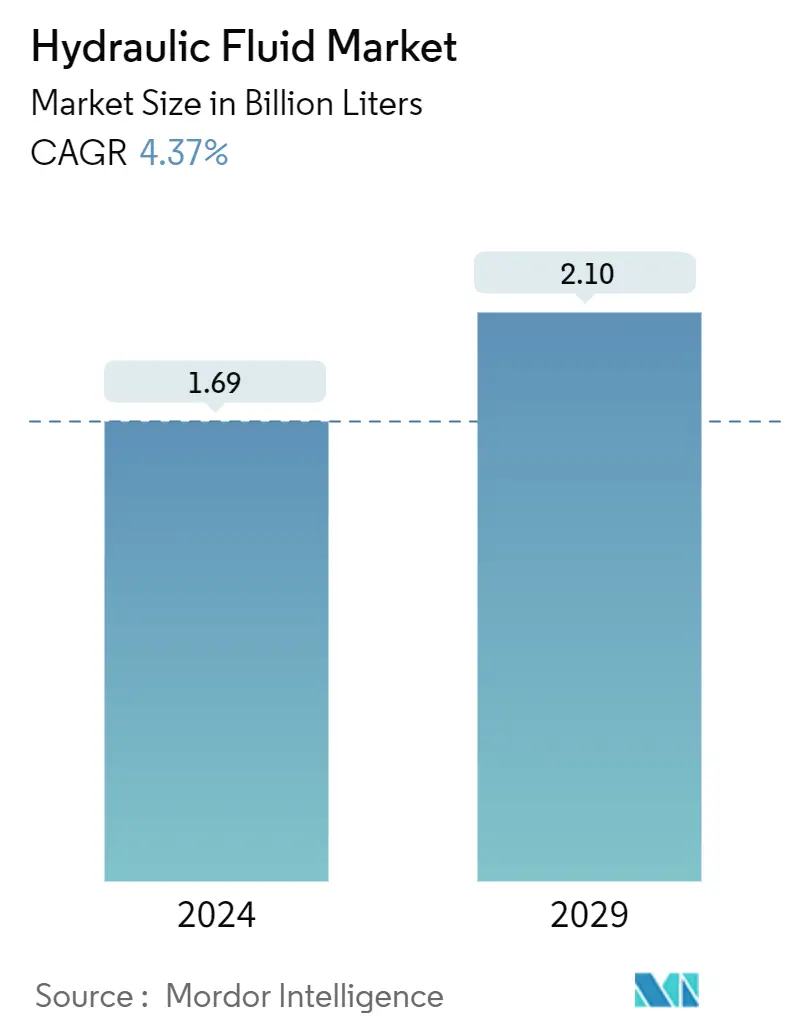Market Size of Hydraulic Fluid Industry

| Study Period | 2019-2029 |
| Base Year For Estimation | 2023 |
| CAGR (2024 - 2029) | 4.37 % |
| Fastest Growing Market | Asia-Pacific |
| Largest Market | Asia-Pacific |
| Market Concentration | High |
Major Players
*Disclaimer: Major Players sorted in no particular order |
Hydraulic Fluids Market Analysis
The Hydraulic Fluid Market size is estimated at 1.69 Billion liters in 2024, and is expected to reach 2.10 Billion liters by 2029, growing at a CAGR of 4.37% during the forecast period (2024-2029).
The COVID-19 pandemic negatively affected the market for hydraulic fluids in 2020. During the pandemic, manufacturing activities in various industries, such as automotive, aerospace, construction, oil and gas, and mining, were halted for a significantly long time. It, in turn, decreased the demand for hydraulic fluids in these industries. However, production in these sectors post-COVID resumed. It is an encouraging sign for the future of the market.
- Over the medium term, the growth of the industrial sector in Asia-Pacific Middle East, and Africa is projected to drive the market.
- On the other hand, the high cost of synthetic and bio-based hydraulic fluids is likely to hinder the market in the coming years.
- Rising consumer awareness of the harmful release of gases due to lubricants and hydraulic fluids is driving the market towards bio-based oils.
- The Asia-Pacific region is expected to dominate the market, with the largest consumption from countries such as India and China.
Hydraulic Fluids Industry Segmentation
Hydraulic fluids are commonly made of mineral oil and water. They act as a medium for transmitting power in hydraulic machinery. Some of the properties of hydraulic fluids include wear resistance, thermal stability, viscosity, compressibility, and oxidation stability.
The market is segmented on the basis of end-user industry and geography. By end-user industry, the market is segmented into automotive, other transportation, heavy equipment, food and beverage, and other end-user industries. The report also covers the market size and forecasts for the hydraulic fluid market in 15 countries around the world. For each segment, the market sizing and forecasts are done on the basis of volume (liters).
| End-user Industry | |
| Automotive | |
| Other Transportation | |
| Heavy Equipment | |
| Food and Beverage | |
| Other End-user Industries(Construction, Oil and Gas, Agriculture, Metal and Mining) |
| Geography | |||||||
| |||||||
| |||||||
| |||||||
| |||||||
|
Hydraulic Fluid Market Size Summary
The hydraulic fluids market is poised for growth over the forecast period, driven by the recovery of industrial activities post-COVID-19. The pandemic had initially disrupted manufacturing in key sectors such as automotive, aerospace, construction, oil and gas, and mining, leading to a temporary decline in demand for hydraulic fluids. However, as these industries have resumed operations, the market is expected to expand. The Asia-Pacific region, particularly countries like China and India, is anticipated to lead the market due to the burgeoning industrial sector and increased automotive production. The demand for hydraulic fluids in the automotive industry is fueled by their essential role in systems like brakes, clutches, and power steering, which require regular maintenance and replacement.
Despite the positive outlook, the market faces challenges, including the high cost of synthetic and bio-based hydraulic fluids, which could impede growth. Nonetheless, there is a growing shift towards bio-based oils, driven by rising consumer awareness of environmental impacts. The construction and aerospace industries in China and Japan, along with India's smart city initiatives, are expected to contribute significantly to market expansion. The market is characterized by a consolidated landscape, with major players such as Royal Dutch Shell, Exxon Mobil, BP, Chevron, and Total playing pivotal roles. These companies are actively involved in strategic developments to maintain their market positions.
Hydraulic Fluid Market Size - Table of Contents
-
1. MARKET DYNAMICS
-
1.1 Drivers
-
1.1.1 Growth of Industrial Sector in Asia-Pacific and Middle-East and Africa
-
1.1.2 The Rise in Production of Crude Oil
-
1.1.3 Increased Use of Hydraulic Fluid in Various Industries Including Construction
-
-
1.2 Restraints
-
1.2.1 Hight Cost of Synthetic and Bio-based Hydraulic Fluids
-
1.2.2 Other Restraints
-
-
1.3 Industry Value Chain Analysis
-
1.4 Porter's Five Forces Analysis
-
1.4.1 Bargaining Power of Suppliers
-
1.4.2 Bargaining Power of Buyers
-
1.4.3 Threat of New Entrants
-
1.4.4 Threat of Substitute Products and Services
-
1.4.5 Degree of Competition
-
-
-
2. MARKET SEGMENTATION (Market Size in Volume)
-
2.1 End-user Industry
-
2.1.1 Automotive
-
2.1.2 Other Transportation
-
2.1.3 Heavy Equipment
-
2.1.4 Food and Beverage
-
2.1.5 Other End-user Industries(Construction, Oil and Gas, Agriculture, Metal and Mining)
-
-
2.2 Geography
-
2.2.1 Asia-Pacific
-
2.2.1.1 China
-
2.2.1.2 India
-
2.2.1.3 Japan
-
2.2.1.4 South Korea
-
2.2.1.5 Rest of Asia-Pacific
-
-
2.2.2 North America
-
2.2.2.1 United States
-
2.2.2.2 Canada
-
2.2.2.3 Mexico
-
-
2.2.3 Europe
-
2.2.3.1 Germany
-
2.2.3.2 United Kingdom
-
2.2.3.3 Italy
-
2.2.3.4 France
-
2.2.3.5 Rest of Europe
-
-
2.2.4 South America
-
2.2.4.1 Brazil
-
2.2.4.2 Argentina
-
2.2.4.3 Rest of South America
-
-
2.2.5 Middle-East and Africa
-
2.2.5.1 Saudi Arabia
-
2.2.5.2 South Africa
-
2.2.5.3 Rest of Middle-East and Africa
-
-
-
Hydraulic Fluid Market Size FAQs
How big is the Hydraulic Fluid Market?
The Hydraulic Fluid Market size is expected to reach 1.69 billion liters in 2024 and grow at a CAGR of 4.37% to reach 2.10 billion liters by 2029.
What is the current Hydraulic Fluid Market size?
In 2024, the Hydraulic Fluid Market size is expected to reach 1.69 billion liters.

